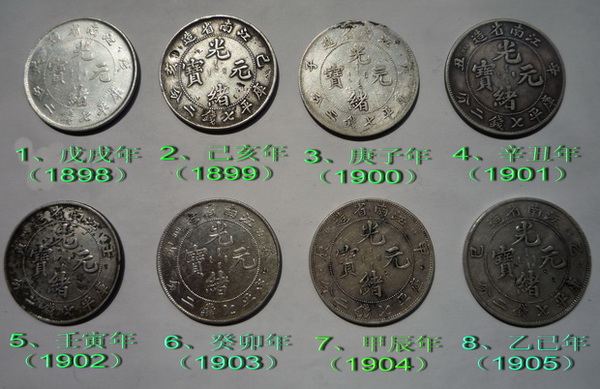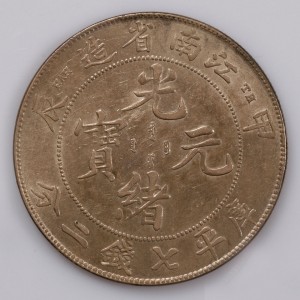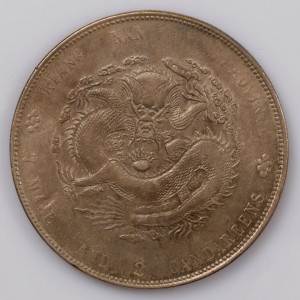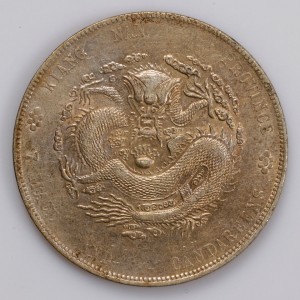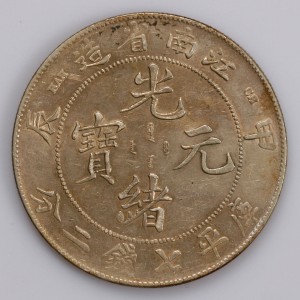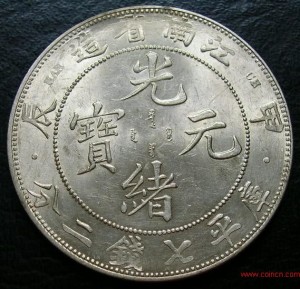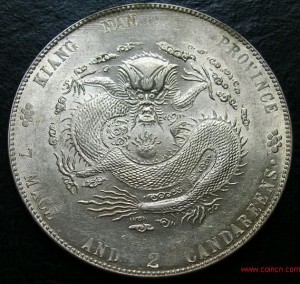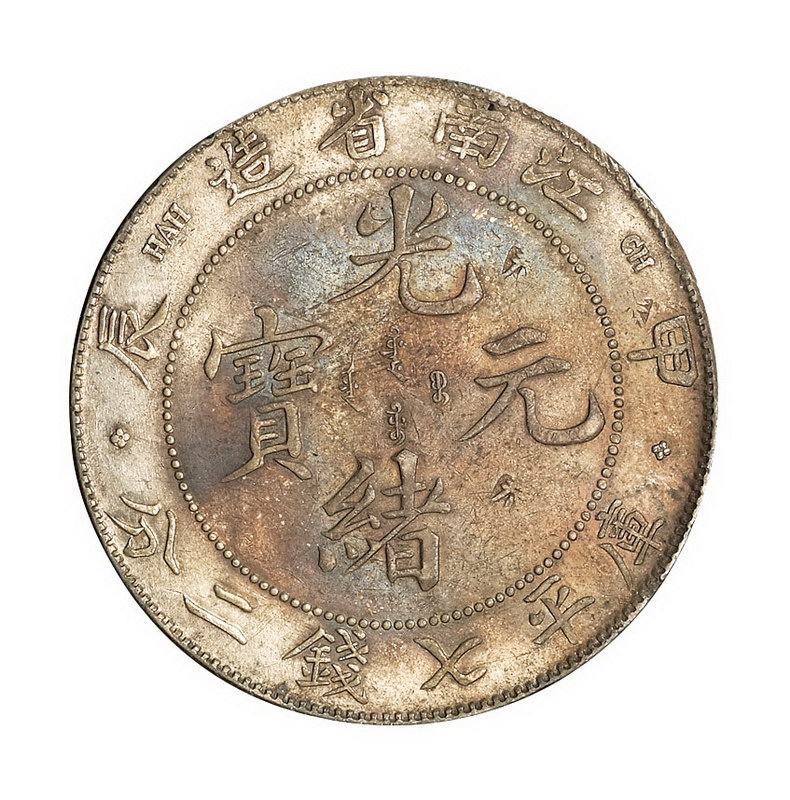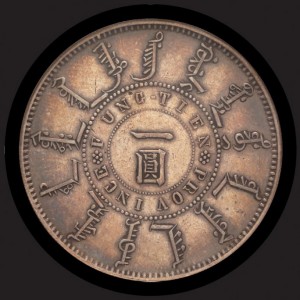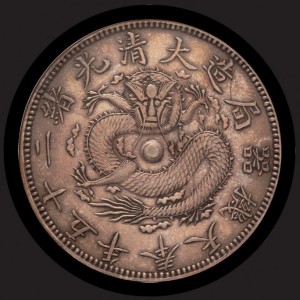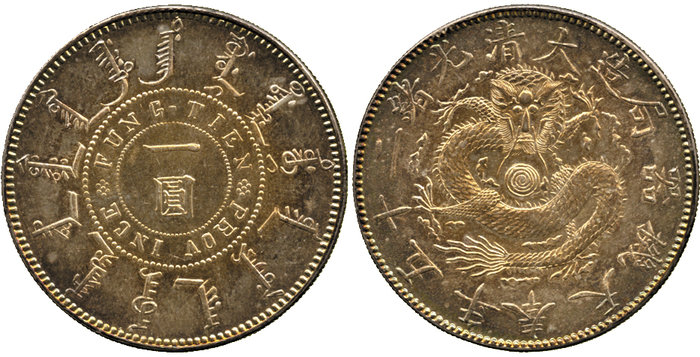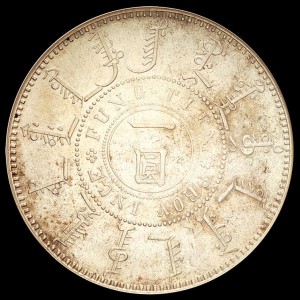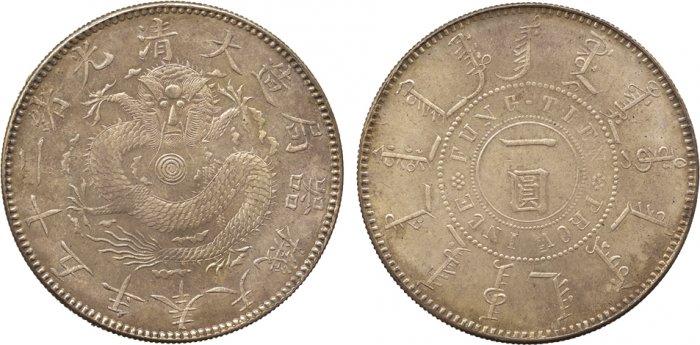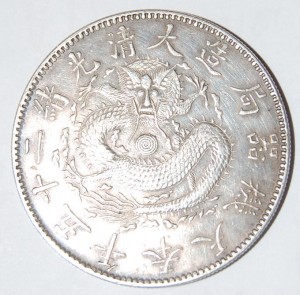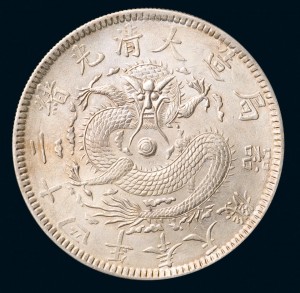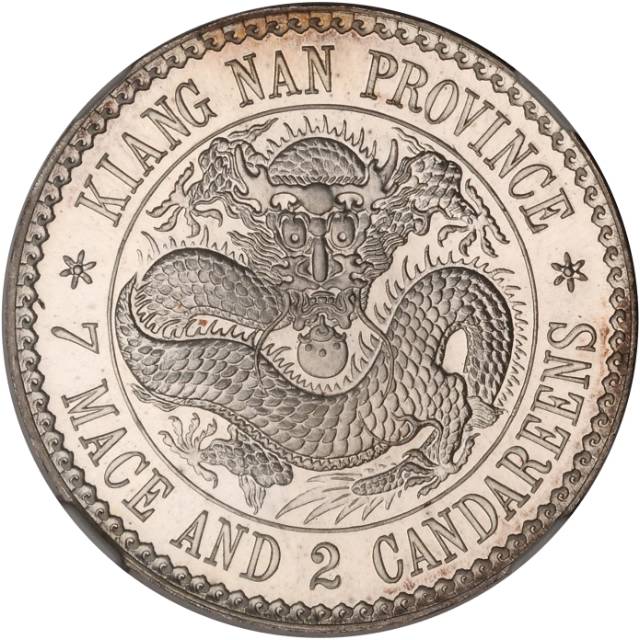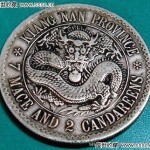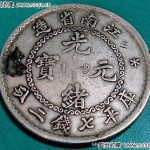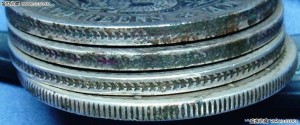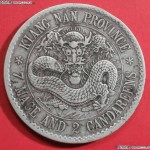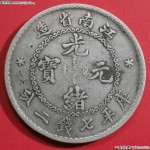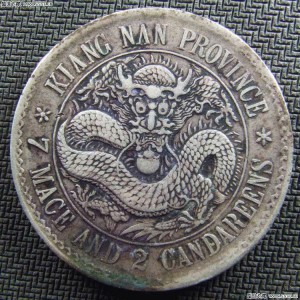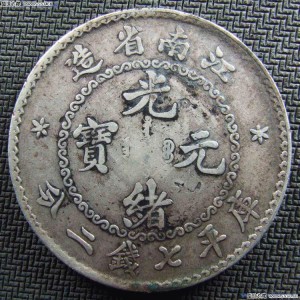Kiangnan dollars were minted at the Nanking mint from 1897 to 1905. Early coins have a unique design and are quite scarce, but from 1899 on, the Nanking mint was one of the most prolific mint in China and the subsequent issues are common chinese coins. Some later years emissions have scarce variations or interesting varieties, though it may not be easy to immediately identify them for the casual collector, since the coins are all dated using the sexagenary cycle of the traditional chinese calendar.
A picture is worth a thousand words: the table below should make it very easy for anyone to identify the year of production of the various Kiangnan dollars.
Amongst them, the 1903 Gui Mao (癸卯) and the 1905 Yi Si (乙巳) coins are the scarcest and most valuable. In this article, I would like however to focus on the 1904 Jia Chen (甲辰) coin, which is more common but has an interesting history.
Starting from 1901, all the Kiangnan coins had some marks added next to the characters indicating the year. In the year of Xin Chou (辛丑), the initials of the British assayer H. A. Holmes, working for the Nanking mint, were apposed on the coins as a guarantee of their purity. Indeed, sloppy minting in the previous years raised concerns that people would start to distrust the coins and return to using the foreign currency circulating at the time. On the Gui Mao (癸卯) coins, a distinctive five pointed rosette was added as well.
In 1904 (Jia Chen (甲辰) year), two different marks were used in addition to the usual HAH initials: TH and CH.
According to the mint records, only one million coins with the TH mark were minted. It is generally supposed that “TH” are the initials of the die engraver, but his name has unfortunately been lost. Some have said that “TH” stood for the first two letters of the name of the auxiliary mint director (副厂长), Deng Ju (邓矩), but this seems unlikely. The Wade-Giles romanisation (in use at the time) of his name would be Teng Chü, not Theng.
While the meaning of the TH initials remains obscure, it is probable that CH does actually stand for the name of the new director of the mint, who took up his functions the same year. At the time, the direction of the mint changed frequently due to the fact it was a very lucrative – and thus, coveted – position. In April 1903, Shen Bang Xian (沈邦宪) was appointed director, then replaced in September of the same year by Pan Ru Jie (潘汝杰), himself succeeded in April 1904 by Zhang Qian Jie (张迁杰)… Zhang Qian Jie was in charge during the time the Jia Chen coin were minted, and the initials of his surname (romanised Chang at the time) match the CH mark.
If this is indeed the meaning of the CH mark, it becomes easier to put a timeline on the production of the different versions of this coin. The coins marked TH use the same design than the previous year, likely because the engraver didn’t had the time yet to complete the new dies. Some CH coins use the old dragon design too, but with a new reverse, as seen below.
Why the haste to engrave a new reverse and put it in production when the obverse wasn’t even completed? Well, it must have been tempting for the newly appointed director to seize the opportunity to immortalise his name on the new dies, knowing full well that his successor in six months would not be able to replace them before the next year… This scheme worked even better than he could have expected when the Jia Chen dies bearing his initials were reused from November 1911 to February 1912, after the fall of the last Emperor.
From this timeline, it is easier to determine which coins were minted during the Qing era and which coins are republican restrikes: coins bearing the TH marks, and early CH coins featuring the old dragon design, were both obviously made in 1904. For subsequent coins, things are somewhat less clear. Coins with the new dragon design and the CH initials have die differences too; and the most common of them is the addition of dots on the reverse.
As seen above, the new dragon design only differs subtly from its predecessor. The face of the dragon and the design of the flame to the left of the central fireball are the most distinctive differences; one can see that the weaker strike on the tail of the dragon (next to its right hindleg) has also been fixed.
The coin pictured above features another interesting difference: a dot has been added next to the denomination. This alteration was probably made on republican restrikes, like the variant of the 1911 imperial silver dollar (with a dot after “DOLLAR”) which was actually minted after the fall of the Manchu regime. Coins with dots on the reverse but without the dot after the denomination were thus quite possibly minted during the Qing era.
A scarcer variation exists, with rosettes instead of dots on the reverse. It is likely that this coin was minted in 1904 as well.
Of all these variations, the coins bearing the TH mark are the scarcest and the most expensive. The CH coins are all much less valuable, due to their relative abundance. This lead less than scrupulous coins dealers to scrub the C out of their common coin, and replace it with a T in an attempt to “upgrade” their coin and sell it for an higher price. Unfortunately for them, these initials is not the only difference between these coins. As we discussed before, some CH coins have the same dragon design than the TH coins, but not all. Even if the counterfeiter is careful and pick the right dragon pattern, the reverse of these coins has obvious differences for the connoisseur.
- The “legs” (3rd and 4th stroke) of the Yuan character, 元, are connected on a genuine TH
- The 甲 character points between the top and middle horizontal bars (1st and 2nd stroke) of the 元 character on a genuine TH coin
- The 甲 character points to the 2nd stroke of the 元 character on a CH coin
- the 辰 character is slightly “higher” (closer to HAH) on a genuine TH coin
As usual, always be careful and exerce your judgement when you buy an old chinese coin !
I recently acquired a new Chinese coin, struck over a century ago at the Fengtien arsenal mint in the nowadays Shenyang (沈阳) city. It is now one of the few cities minting coins for the People’s Bank of China, along with Shanghai and Shenzhen. Today one of the biggest cities of China and an industrial powerhouse, Shenyang can trace the beginning of its transformation in a heavy industry titan back to the establishment of the Fengtien machine bureau (奉天机器局) in the late Qing era.
The Ancestor of the Shenyang Mint: the Fengtien Machine Bureau
Created in 1897 at the instigation of the General Iktangga (依克唐阿), governor of the Fengtien province, the bureau was destined to modernize the provincial coinage. An early set of dies was commissionned from the Anqing (安庆) mint in Anhwei (安徽), and German-made steam-powered machinery were brought from Tianjin. The early test issues using the An Hui dies were denominated in maces and candareens, and were designed after the Kwantung dollar. With the success of the Peiyang arsenal dollars, subsequent issues were however redesigned and the first emission meant for circulation in 1898 features a reverse bearing the characteristic circular manchu writings in the style of the contemporary Beiyang coins.
The last emission, in 1899, has a very similar design. As far as I know, three dies were used for the 25th year of Guang Xu series. The coin I bought is of the first type, as seen below:
The first set of die used has a single dotted ring around the denomination on the reverse (单圈版 in Chinese). The reverse has an obvious error in the typography of the province name, with a huge empty space between the F and U of FUNG TIEN. The strike is also noticeably weak from the G to the T. On the obverse, this die is very different from the subsequent ones. The dragon face is beautiful, with some relief on the sides of the dragon nose and a large, “smiling” mouth. The fireball at the center is ornamented with a wide, incomplete spiral probably resulting from a weak strike.
The second strike features a new dragon design; the reverse issues were also partially fixed:
The province name on the reverse is now correctly typographied, but the strike is still weak on the area from the G to the T. The new dragon design is very different from the previous issue, with a flatter face and a thinner mouth. The spiral on the fireball is complete this time, running all the way to the center.
The last emission tries again to correct the problems of the reverse, keeping the new dragon design.
As seen here, the G and T are indeed slightly stronger, but the end of “TIEN” is weaker, while it was crisp in the previous strikes… It seems that like the Kiangnan mint, the early Shenyang mint had troubles with the die adjustement and thus produced weakly struck coins.
A solid circle was added around the denomination, inside the inner dotted circle.
This strike is known as the “Linear circle within dotted circle” die, or 双圈版 in Chinese.
After this third strike, the mint machinery was seized by the tsarist Russian army and the Shenyang machine bureau was burned down… The province of Fengtien (nowadays Liao Ning) was indeed going through dark times. Already the theater of the first Sino-Japanese war in 1895, it was then the scene of the conflict between the Russians controlling the leased territory of Liao Tung, and the Japanese army, leading to the Russo-Japanese war. The mint at the Shenyang machine bureau was briefly brought back online in 1903 after years of reconstruction slowed down by the Boxer rebellion.
Eventually, the province fell under Japanese control, later becoming part of the Manchukuo puppet state. The Japanese army and investors continued to develop heavy industries in the region, furthering the move toward automatization that had begun in 1897 with the creation of the Fengtien machine bureau.
Beware of the Forgeries !
As usual, if a coin is rare, a lot of fakes tend to surface around. The example below is interesting :
The fake coin mixes happily the chinese calligraphy of the 1898 coin with the 1899 first dragon design, except for the fireball which has a complete spiral…
The “Lao Kiang Nan” (老江南) silver coin is one of the most sought after chinese dragon dollars. The Heaton Mint at Birmingham was commissioned in 1897 to produce a series of five silver denominations for the Nanking Mint. Upon completion, a small number of proof strikes along with sets of dies were shipped to the mint in Nanking. After their arrival the mint began production using the original Heaton Mint design, the only modification being the addition of a security edge.
The first set minted by the Nanking mint for circulation, and the scarcest, has a reeded edge. The english legend has some distinctive differences: the weak crossbars of the “A” in “KIANG NAN” make them look like inverted “V”. Also, the calligraphy of the character 省 on the reverse was modified (the top of the 目 part of the character is open).
Subsequent strikes used an ornamented edge; this type is called 人字齿 or 人字边 by Chinese collectors, due to the pattern. The Lao Kiang Nan with an ornamented edge are far more common, and less expensive. You can see below a comparison of the edges of three ornamented edge Lao Kiang Nan, and one reeded edge:
Amongst the ornamented edge strikes, there is few known die differences. Even “common” Lao Kiang Nan coins are still quite scarce!
***
The ornamented edge Lao Kiang Nan is closer to the original design from the Heaton mint: the english lettering is identical, but the Chinese calligraphy used is the same than on the reeded edge. This is the most commonly found type of Lao Kiang Nan.
An early type of ornamented edge Lao Kiang Nan is much scarcer, with a reverse identical to the original Heaton design. It is called 人字齿目省 in China.
It is difficult nowadays to find uncirculated, even XF grade Lao Kiang Nan silver coins. Beautiful genuine coins are hoarded by collectors, so the market is saturated by fake or low grade coins. Outside of auction houses, finding a good looking reeded edge Lao Kiang Nan can be quite a challenge. The value of Qing era Chinese silver coins has soared in the recent years, and as one of the most coveted dragon dollar, the Lao Kiang Nan is no exception: an XF-45, uncleaned, reeded edge Lao Kiang Nan can be easily sold for 5000€.
